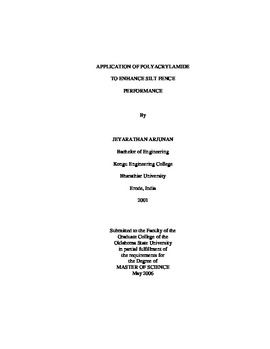| dc.contributor.advisor | Gasem, Khaled A. M. | |
| dc.contributor.author | Arjunan, Jeyarathan | |
| dc.date.accessioned | 2014-04-16T03:07:05Z | |
| dc.date.available | 2014-04-16T03:07:05Z | |
| dc.date.issued | 2006-05-01 | |
| dc.identifier.uri | https://hdl.handle.net/11244/9616 | |
| dc.description.abstract | Conventional barrier methods of erosion control, in particular the silt fence, have demonstrated poor performance at trapping clays and fine silts due to inadequate detention time for settling. Trapping efficiency can be improved by flocculation of clays into larger particles with higher settling velocities. Studies have shown that clay flocculation can be induced by anionic polyacrylamides (PAM) in conjunction with divalent cations. Although anionic PAM is available commercially with different charge densities and molecular weights, the flocculation characteristics of a given anionic PAM are not the same for all soils. The purpose of this study was to investigate the flocculation characteristics of three anionic PAMs on the silty clay loam soil. Jar test experiments were conducted to treat the sediment with PAM and divalent cations. Flocculation efficiency and suspended solid concentration (SSC) were determined with the experimental protocol developed. Specifically, a sequential experimental approach was implemented to determine the (a) PAM type and concentration, and (b) calcium ion concentration that produce high flocculation efficiency and %SSC reduction. The three PAM flocculants considered in this study (PAM10, PAM20 and PAM30) produced the same flocculation characteristics for the silty clay loam soil. PAM played a much more vital role in increasing flocculation efficiency and reducing the suspended solid concentration than did CaCl2 (exchangeable cations). The effective operating range for PAM and CaCl2 concentrations for desired flocculation efficiency and %SSC reduction were found to be 0.05-5 ppm and 1.5-3.5 mmole, respectively. There was a threshold limit after which the flocculation efficiency and %SSC reduction decreases with increase in PAM concentration. This supports the statement: "Application rates of anionic PAM above those suggested by the manufacturer will not provide additional effectiveness." | |
| dc.format | application/pdf | |
| dc.language | en_US | |
| dc.publisher | Oklahoma State University | |
| dc.rights | Copyright is held by the author who has granted the Oklahoma State University Library the non-exclusive right to share this material in its institutional repository. Contact Digital Library Services at lib-dls@okstate.edu or 405-744-9161 for the permission policy on the use, reproduction or distribution of this material. | |
| dc.title | Application of Polyacrylamide to Enhance Silt Fence Performance | |
| dc.type | text | |
| dc.contributor.committeeMember | Barfield, Bill J. | |
| dc.contributor.committeeMember | Stevens, Ellen W. | |
| dc.contributor.committeeMember | Robinson, Robert S., Jr. | |
| dc.contributor.committeeMember | Warde, William D. | |
| osu.filename | Arjunan_okstate_0664M_1837.pdf | |
| osu.college | Engineering, Architecture, and Technology | |
| osu.accesstype | Open Access | |
| dc.description.department | School of Chemical Engineering | |
| dc.type.genre | Thesis | |
| dc.subject.keywords | polyacrylamide | |
| dc.subject.keywords | silt fence | |
| dc.subject.keywords | sediment control | |
